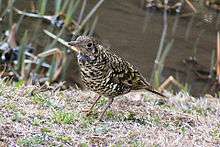Asian thrush
The Asian thrushes are medium-sized mostly insectivorous or omnivorous birds in the genus Zoothera of the thrush family, Turdidae. The genus name Zoothera comes from the Ancient Greek zoon, "animal" and theras, "hunter".[1]
| Asian thrushes | |
|---|---|
 | |
| White's thrush (Zoothera aurea) | |
| Scientific classification | |
| Kingdom: | Animalia |
| Phylum: | Chordata |
| Class: | Aves |
| Order: | Passeriformes |
| Family: | Turdidae |
| Genus: | Zoothera Vigors, 1832 |
| Species | |
|
21, see text | |
Two New World species traditionally regarded as Zoothera (varied thrush and Aztec thrush) actually belong elsewhere in the thrush family. A group containing Siberian thrush and the African species is not closely related to the other Zoothera and are now assigned to the genus Geokichla.
Species in taxonomic order
The following species are recognised in the genus Zoothera[2]
- Geomalia (Zoothera heinrichi)
- Everett's thrush (Zoothera everetti)
- Sunda thrush (Zoothera andromedae)
- Alpine thrush (Zoothera mollissima)
- Sichuan thrush (Zoothera griseiceps)
- Himalayan thrush (Zoothera salimalii)
- Long-tailed thrush (Zoothera dixoni)
- White's thrush (Zoothera aurea)
- Amami thrush (Zoothera major)
- Scaly thrush (Zoothera dauma)
- †Bonin thrush (Zoothera terrestris) - extinct (c. 1830s)
- Nilgiri thrush (Zoothera neilgherriensis)
- Sri Lanka thrush (Zoothera imbricata)
- Fawn-breasted thrush (Zoothera machiki)
- Russet-tailed thrush (Zoothera heinei)
- Bassian thrush (Zoothera lunulata)
- Black-backed thrush (Zoothera talaseae)
- Makira thrush (Zoothera margaretae)
- Guadalcanal thrush (Zoothera turipavae)
- Long-billed thrush (Zoothera monticola)
- Dark-sided thrush (Zoothera marginata)
Traditional Zoothera species belonging elsewhere in family
- Varied thrush (Ixoreus naevius) - related to other new world genera
- Aztec thrush (Ridgwayia pinicola) - related to Hylocichla
Geokichla thrushes
- Slaty-backed thrush (Geokichla schistacea)
- Pied thrush (Geokichla wardii)
- Ashy thrush (Geokichla cinerea)
- Orange-sided thrush (Geokichla peronii)
- Orange-headed thrush (Geokichla citrina)
- Spot-winged thrush (Geokichla spiloptera)
- Siberian thrush (Geokichla sibirica)
- Abyssinian ground thrush (Geokichla piaggiae)
- Kivu ground thrush (Geokichla piaggiae tanganjicae)
- Crossley's ground thrush (Geokichla crossleyi)
- Orange ground thrush (Geokichla gurneyi)
- Black-eared ground thrush (Geokichla cameronensis)
- Grey ground thrush (Geokichla princei)
- Spotted ground thrush (Geokichla guttata) - formerly G. fischeri
- Oberländer's ground thrush (Geokichla oberlaenderi)
- Buru thrush (Geokichla dumasi)
- Seram thrush (Geokichla joiceyi)
- Chestnut-capped thrush (Geokichla interpres)
- Enggano thrush (Geokichla leucolaema)
- Red-backed thrush (Geokichla erythronota)
- Red-and-black thrush (Geokichla mendeni)
- Chestnut-backed thrush (Geokichla dohertyi)
gollark: We should drop entirely prizes on one random day per three months.
gollark: So it hatches sooner.
gollark: When you want to reduce its time.
gollark: I'm going to pretend it doesn't exist until, what, the 25th, then panic and throw away eggs to get space.
gollark: For Halloween or something?
References
- Jobling, James A (2010). The Helm Dictionary of Scientific Bird Names. London: Christopher Helm. p. 414. ISBN 978-1-4081-2501-4.
- Gill F. and Donsker D. (eds), Thrushes in «IOC World Bird Names (ver 10.1)», International Ornithologists’ Union, 2020.
Further reading
- Klicka, J., G. Voelker, and G.M. Spellman. 2005.A molecular phylogenetic analysis of the ‘‘true thrushes’’ (Aves: Turdinae). Molecular Phylogenetics and Evolution 34: 486–500.
- Sangster, G., J.M. Collinson, P.-A. Crochet, A.G. Knox, D.T. Parkin, L. Svensson, and S.C. Votier. 2011. Taxonomic recommendations for British birds: seventh report. Ibis 153: 883–892.
- Voelker, G., and J. Klicka. 2008. Systematics of Zoothera thrushes, and a synthesis of true thrush molecular systematic relationships. Molecular Phylogenetics and Evolution 49: 377–381.
- Voelke, G., and R.K. Outlaw. 2008. Establishing a perimeter position: speciation around the Indian Ocean Basin. Journal of Evolutionary Biology 21: 1779–1788.
External links
| Wikimedia Commons has media related to Zoothera. |
- Asian thrush videos on the Internet Bird Collection
This article is issued from Wikipedia. The text is licensed under Creative Commons - Attribution - Sharealike. Additional terms may apply for the media files.